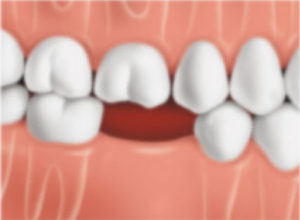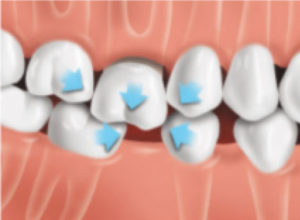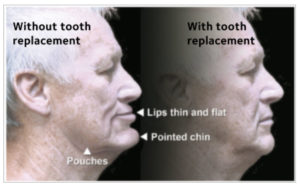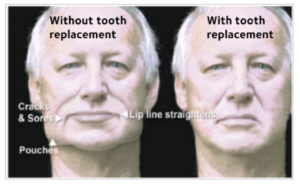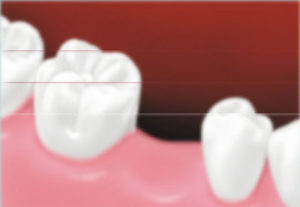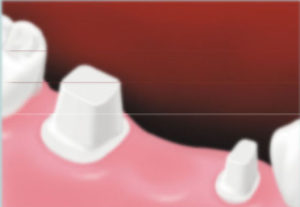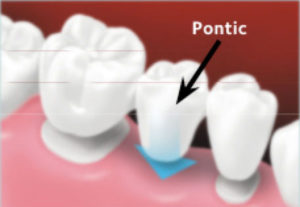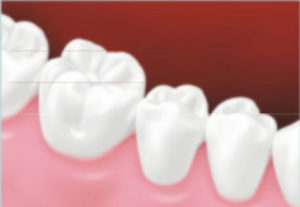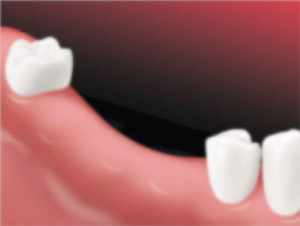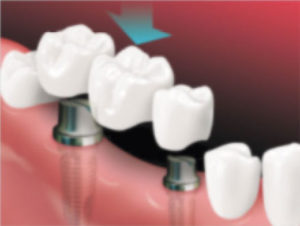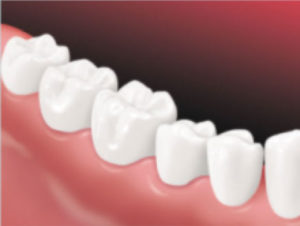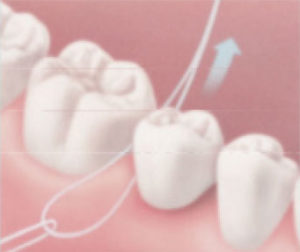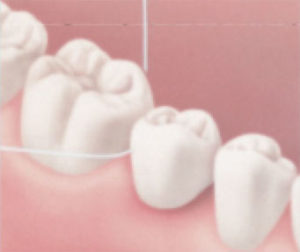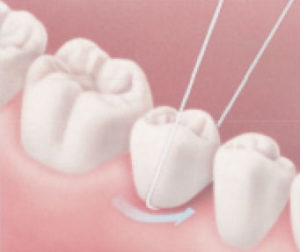
A bridge is a custom-made replacement tooth or teeth that fill the space where one or more teeth are missing.
The bridge permanently restores your bite and helps keep the natural shape of your face.
This brochure reviews the types of non-removable bridges available and the steps involved in placing your bridge. Your dentist can recommend which type of bridge is best for you based on your specific needs.
WHY YOU NEED A BRIDGE
A missing tooth is a serious matter. Teeth are made to work together to help you chew, speak and smile. When you lose a tooth, the nearby teeth may shift and become crooked. This may make it harder to speak or chew. A missing tooth in the lower jaw may cause a tooth in your upper jaw to shift down into that space, meaning your teeth will no longer be even or in a straight line. This can affect your bite and place more stress on your teeth and jaw joints, possibly causing pain and damage.
Teeth that have tipped or drifted are also harder to clean. This can increase the risk for tooth decay and gum disease.
Missing teeth can lead to bone loss, which can cause neighboring teeth to become loose and can lead to facial collapse. If that happens, it may change the way the jawbone supports the lips and cheeks. Over time, this can make your face look older.
Drifting teeth
Position of teeth immediately after a tooth is lost.
If the tooth is not replaced, other teeth can drift out of position and change the bite.
Facial collapse
When teeth are lost and not replaced, the face looks older. The lips appear thin and flattened. The chin moves forward and upward and appears pointed.
Also, the mouth loses some of its shape, and the lip line straightens. Pouches become pronounced on either side of the lower jaw. Cracks and sores may form at the corners of the mouth.
FIXED BRIDGE
To place a fixed bridge, your dentist uses an existing natural tooth or teeth to help hold your bridge in place. Fixed bridges are cemented in place and only a dentist can remove them. This makes them feel stable and very similar to your natural teeth.
An artificial tooth, called a pontic, takes the place of the missing tooth. The pontic is secured by one or more crowns, which are bonded to the teeth on either side of the missing tooth.
Placing a bridge takes several dental visits. Depending on your needs, one or more teeth may be prepared to hold the bridge. Let’s use the example of a bridge supported by two teeth:
- On the first visit, your dentist prepares the teeth on both sides of the gap. The bridge will attach to those teeth. Once these teeth are prepared for placement of the bridge, they will permanently lose their natural look and shape.
- Your dentist then makes an impression or an image of your teeth and the space. This information is sent to a dental laboratory where lab technicians follow your dentist’s instructions and make the bridge.
- Your dentist will place a temporary bridge to protect your prepared teeth while you are waiting for the permanent bridge.
- When the permanent bridge is ready, your dentist fits, adjusts and cements the bridge to the prepared teeth. This type of bridge is permanent and cannot be taken out of your mouth without a dentist’s help.
IMPLANT-SUPPORTED BRIDGE
An implant-supported bridge is a bridge that is attached to one or more metal posts that are surgically implanted into your jawbone. The posts act like the roots of natural teeth. The bridge, which has replacement teeth mounted on a tooth-colored base, attaches to these metal posts. A key benefit of an implant-supported bridge is that it doesn’t need support from the surrounding teeth.
An implant-supported bridge requires surgery to place the post into the bone. Candidates for dental implants should be in good general health and have enough bone to support an implant.
Implants may be placed in one day or may require multiple visits depending on the existence of a previous infection, the availability of bone to hold the implant and your dentist’s treatment plan.
WHAT MATERIALS ARE USED IN A BRIDGE?
Bridges are made from metal, ceramics or a combination of the two. Your dentist will talk with you about the materials that are best for you and your mouth.
Fixed bridge
Missing tooth
To replace a missing tooth with a conventional three-unit bridge, teeth next to the gap are reduced.
The custom-made bridge is placed over the prepared teeth.
After adjustments are made, the bridge is cemented into place.
Implant-supported bridge
Missing teeth
A bridge is placed on implants
After the bridge is placed
CARING FOR YOUR BRIDGE
A bridge can become loose if the support teeth or the jawbone are damaged by dental disease. Follow these tips for good oral health:
- Brush your teeth twice a day and clean between your teeth using floss or another between-the-teeth cleaner every day. Brushing and cleaning between your teeth helps remove plaque, a sticky film of bacteria that is always forming on the teeth.
- Always clean between your teeth and under the bridge. You can consider using a water flosser or specially shaped brushes, threaders and other devices to clean around your bridge and your natural teeth. The choice is yours—which ever works best for you. Your dentist or dental hygienist can show you how to use these products to clean around your bridge.
- See your dentist regularly for exams and professional cleanings.
- Eat a healthy diet.
- Look for oral care products that display the ADA Seal of Acceptance. These products are scientifically proven to be safe and effective in keeping your mouth healthy.
FLOSSING UNDER A BRIDGE
Using a floss threader, insert floss under the bridge.
Gently rub the side of each tooth next to the bridge with the floss, cleaning under the gum, too.
Rub the floss from side to side along the underside of the pontic.

